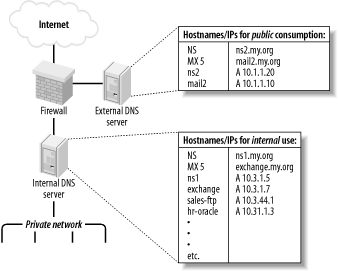

|
|
6.2 DNS Security PrinciplesDNS security can be distilled into two maxims: always run the latest version of your chosen DNS software package, and never provide unnecessary information or services to strangers. Put another way, keep current and be stingy! This translates into a number of specific techniques. The first is to limit or even disable recursion, since recursion is easily abused in DNS attacks such as cache poisoning. Limiting recursion is easy to do using configuration-file parameters; disabling recursion altogether may or may not be possible, depending on the name server's role. If, for example, the server is an "external" DNS server whose sole purpose is to answer queries regarding its organization's public servers, there is no reason for it to perform look-ups of nonlocal hostnames (which is the very definition of recursion). On the other hand, if a server provides DNS resolution to end users on a local area network (LAN), it definitely needs to recurse queries from local hosts but can probably be configured to refuse recursion requests, if not all requests, from nonlocal addresses. Another way to limit DNS activity is to use split DNS services (Figure 6-2). Split DNS, an example of the "split services" concept I introduced in Section 2.3 refers to the practice of maintaining both "public" and "private" databases of each local name domain (zone). The public-zone database contains as little as possible: it should have NS records for publicly accessible name servers, MX records of external SMTP (email) gateways, A-records (aliases) of public web servers, and entries pertinent to any other hosts that one wishes the outside world to know about. Figure 6-2. Split DNS The private-zone database may be a superset of the public one, or it may contain entirely different entries for certain categories or hosts. The other aspect to DNS "stinginess" is the content of zone files themselves. Even public-zone databases may contain more information than they need to. Hosts may have needlessly descriptive names (e.g., you may be telling the wrong people which server does what), or too-granular contact information may be given. Some organizations even list the names and versions of the hardware and software of individual systems! Such information is almost invariably more useful to prospective crackers than to its intended audience. Maintaining current software and keeping abreast of known DNS exposures is at least as important as protecting actual DNS data. Furthermore, it's easier: the latest version of BIND can always be downloaded for free from ftp://ftp.isc.org, and djbdns from http://cr.yp.to. Information about general DNS security issues and specific BIND and djbdns vulnerabilities is disseminated via a number of mailing lists and newsgroups (some of which are listed at the end of this chapter). There are actually third and fourth maxims for DNS security, but they're hardly unique to DNS: take the time to understand and use the security features of your software, and, similarly, know and use security services provided by your DNS-registration provider. Network Solutions and other top-level-domain registrars all offer several change-request security options, including PGP. Make sure that your provider requires at least email verification of all change requests for your zones! |

|
|